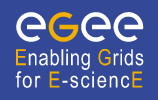Speaker
Report on the experience (or the proposed activity). It would be very important to mention key services which are essential for the success of your activity on the EGEE infrastructure.
Starting from these reasons, a Grid based platform, the BMPortal (Bio-Medical Portal), has been developed as a core block that can rely on different specific Grid environments able to integrate data storage, retrieval, and analysis in several fields of biomedicine. Currently available middleware is gLite but a native Globus and a Nordugrid plugin are planned.Using BMPortal, three different approaches can be followed: first, developers can implement entire plugin for a given middleware or only interfaces/services on available infrastructures. Then, “power users” may implement application and research tools based upon the atomic component available, i.e. combining workflow of services. Finally, end users (clinical, research) only connect to the portal to use the available high-level interfaces.This approach -based on a strong work on data integration- allows contributions as SOAP services from third party developers improving interoperability.
Describe the added value of the Grid for the scientific/technical activity you (plan to) do on the Grid. This should include the scale of the activity and of the potential user community and the relevance for other scientific or business applications
Both for storage of distributed biomedical data and metadata, and for access to distributed analysis tools, a Grid based approach may provide a shared, standardized and reliable solution. Using certificates and the security infrastructure of the Grid, applications can expose data and resources according to fine grained user permissions. This allows developers to implement authentication and authorization schemas easily and on top of industry standard tools (GSI). This is useful in three main situations: (a) constrain access to biomedical data according to strict security and privacy policies, (b) constrain access to storage and computing resources according to given policies and (c) allow for accounting, in the perspective of a service based environment.
The complexity and heterogeneity of data and services should be hidden from unpractised users: the adoption of a Grid portal and workflow execution tools can help developers to implement really user friendly applications.
Describe the scientific/technical community and the scientific/technical activity using (planning to use) the EGEE infrastructure. A high-level description is needed (neither a detailed specialist report nor a list of references).
According to the Virtual Physiological Human paradigm, integration is often required among different levels and disciplines.Due to such an integrated approach, clinical and genomic studies tend to converge in more complex multiscale biomedical experiments to open the way to new research goals. Virtual experiments on the grid can be used to assess and validate models describing human or animal biological subsystems, even if they require large computing or storage resources.
Abstracts for online demonstrations must provide a summary of the demo content. Places for demos are limited and this summary will be used as part of the selection procedure. Please include the visual impact of the demo and highlight any specific requirements (e.g. network connection). In general, a successful demo is expected to have some supporting material (poster) and be capable of running on a single screen or projector.
Several use cases have already been implemented and they could be demonstrated through the connection to a Grid portal available on Internet. A standard web browser and Internet connection are the only tools required to show the demo.
As example of atomic service, we are able to show a tool for the analysis of gene expression microarray data performed by a grid version of the dChip software ported on the gLite, using GFAL APIs for remote data access through the Grid.
Then the demo could show how atomic services like dChip can be combined in more complex virtual experiments: workflow will be executed and monitored on the portal using client tool Taverna and BMPortal authentication. Workflows on the portal can be also exposed as normal atomic services themselves thus allowing an unprecedented flexibility in combining available tools recursively.
